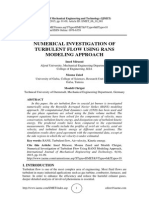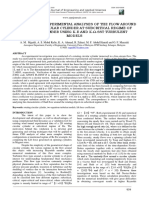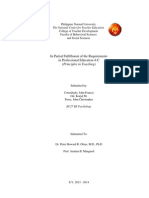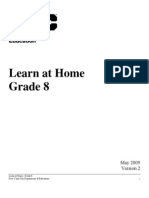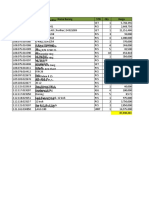Calculation of Flow Field of Diffused Pneumatic Silencer
Calculation of Flow Field of Diffused Pneumatic Silencer
Uploaded by
hyu2in4Copyright:
Available Formats
Calculation of Flow Field of Diffused Pneumatic Silencer
Calculation of Flow Field of Diffused Pneumatic Silencer
Uploaded by
hyu2in4Original Title
Copyright
Available Formats
Share this document
Did you find this document useful?
Is this content inappropriate?
Copyright:
Available Formats
Calculation of Flow Field of Diffused Pneumatic Silencer
Calculation of Flow Field of Diffused Pneumatic Silencer
Uploaded by
hyu2in4Copyright:
Available Formats
Proceedings of the 6th JFPS International
2B3-2 Symposium on Fluid Power, TSUKUBA 2005
November 7-10, 2005
Calculation of Flow Field of Diffused Pneumatic Silencer
Zhang Xi-wen Zhang Yan Li Heng He Feng
SMC-Tsinghua University Pneumatic Technology Center
School of Aerospace, Tsinghua University, 100084, Beijing, China
(E-mail: zhangxiw@tsinghua.edu.cn)
ABSTRACT
Diffused pneumatic silencer has been widely used in pneumatic fields because of its small dimensions and high
performance on noise reduction. Numerical simulation of its interior and exterior flow field is important to studying the
gas flow in the silencer and the flow structure outside the silencer, understanding the mechanism of its noise reduction.
Porous media model and Darcy-Forchheimer principle are used as the basic theoretical frame in this paper. The unified
governing equations are used to describe the compressible flow in and out of the silencer. Robust numerical scheme is
used to discritize the equations and the TDBC(Time-dependent boundary conditions) is used to treat the non-reflect
boundaries. The detailed structures of the inner and outer flow field of the diffused pneumatic silencer are gotten. The
results of the simulation display the characteristics of the flow in the silencer. And the structure of the flow outside the
silencer that can be compared with the experimental data is gotten.
KEY WORDS
Diffused pneumatic silencer, Numerical simulation, Flow field
INTRODUCTION
Pneumatic technology is widely applied in many fields Porous anechoic material is the main component in a
of industrial production, but its application brings diffused pneumatic silencer, and the gas flow through the
exhaust noise, which contaminates circumstance, porous media is compressible gas flow in which pressure,
disserves health, and reduces efficiency of production. density and velocity change conspicuously. As a result,
Diffused pneumatic silencer is widely used in pneumatic the flow field in diffused pneumatic silencer is so
fields because of its small dimensions and high difficult that few numerical investigations have been
performance on noise reduction. Numerical simulation of made so far.
its interior and exterior flow field is significant for the There are two kinds of conventional numerical
study of the gas flow in the silencer and the flow methods which simulate the flow in the district where
structure outside the silencer, understanding the porous materials and pure fluid couple: one uses Darcy
mechanism of its noise reduction, optimum design of the or Forchheimer equations and slip boundary conditions,
structure of the silencer. and the other uses Brinkman or Brinkman-Forcheimer
equations[1]. However, the governing equations in these
374 Copyright © 2005 by JFPS, ISBN 4-931070-06-X
methods aim at special flow problems, so the scope to vapor generator and core of a nuclear reactor, Karayannis
use them is limited. In addition, there is no uniform and Markatos[4] simulated the flow in a exchanger,
method to choose governing equations, that is, governing Prithiviraj and Andrews[5][6] simulated the flow in a
equations are chosen empirically. three-dimensional exchanger.
The numerical simulation method basing on porous In this paper, porous media model is adopted,
media model was initially used to simulate the flow and compressible gas flow in and outside a diffused
heat exchange in nuclear reactors and exchangers. There pneumatic silencer is described with uniform and
are many pipes and flakes in a exchanger, so a great modified N-S equations, and the source terms in
number of meshes are needed to simulate the flow in equations are determined with Darcy-Forcheimer law.
detail. Patankar and Spalding[2] (1974) gave out a method Equations are discretized by using NND format which
which adopts distributive resistance, it was called porous has good stability and high accuracy, no-reflect boundary
media model method. In this method, the influence of conditions are dealt with by using time-dependent
solid structure (pipes in a exchanger) on mass is reflected boundary conditions. Numerical simulation on the flow
with porosity and surface permeability, the influence on field in and outside a diffused pneumatic silencer is made,
momentum is reflected with distributive resistance; the inner and external flow fields of a diffused pneumatic
influence on energy is reflected with distributive heat silencer are got, and the results of numerical simulation
source, then the flow can be simulated with sparser on external flow field can be compared with experiment.
meshes. Using this method, Sha[3] simulated the flow in a
u0,p0,T0
Shell Grille shell Porous media Porous materials
Input End cover in silencer
u1,p1,T1
Figure 1.Structure of a diffused pneumatic silencer
DIFFUSED PNEUMATIC SILENCER Experiment about the gas flowing in a silencer was
performed, the purpose was to provide necessary
A diffused pneumatic silencer is composed of three parameters for numerical simulation and validate the
parts: a silencer shell, porous materials and a end-cover. result of numerical simulation. The velocity of the gas
Its structure can be seen in figure 1. flowing into a silencer is 65.1m/s, and the pressure is
1.6602×105 Pa, the gas pressure turns to 1.013×105 Pa
PHYSICAL MODEL after effusing the silencer, the temperature is 298K,
porosity of porous materials is 0.86, permeability K is
In figure 1, high pressure gas which has the 1.21×10-11m2, and the inertia coefficient CF is
temperature of T1 , density of ρ1 , pressure of p1 goes 0.91×105m-1.
through a silencer at the axial velocity of u1 , because of
the resistance of the end cover, the gas will effuse in the GOVERNING EQUATIONS
radial direction, and the velocity turns to u0 , pressure
turns to p 0 , density turns to ρ 0 , temperature turns to N-S equation for integral unsteady axis-symmetrical
T0 . This is the compressible axis-symmetrical flow compressible fluid is shown below [7]
which goes through a zone coupling porous media and
∂ v v S
∂t ∫∫∫ ∫∫S ⋅ AdS + ∫∫∫
pure fluid. QdV + n dV = 0 (1)
V V
r
EXPERIMENT PARAMETERS
375 Copyright © 2005 by JFPS, ISBN 4-931070-06-X
v
where Q is a variable to be resolved,
v v flow is normal Darcy flow, that is, there is linear relation
A = ( E − E v )ex + ( F − Fv )er , E and F are between pressure gradient and velocity.
non-viscous fluxes in the directions of x and r When 1 < Re K < 10 , the flow is not Darcy flow, the
respectively, E v and Fv are viscous fluxes in the linear relation between pressure gradient and velocity is
directions of x and r respectively, S is the source term not tenable, Forcheimer modification to flow equation is
in the axis-symmetrical N-S equation. needed, but the flow is still laminar flow [9], this kind of
According to the porous media model [2], modified N-S flow is the so-called Darcy-Forcheimer flow. Along with
equation for unsteady axis-symmetrical compressible the increase of velocity, the flow in porous media will
flow in porous media can be gotten from (1) turn to turbulent flow. How to differentiate the turbulent
∂ v v S S por flow in porous media has been a problem in the research
∂t ∫∫∫ ∫∫ a n ⋅ AdS + ∫∫∫ a
av QdV + n v dV + ∫∫∫ av dV = 0 domain, there is not a definite criterion so far. Seguin’s
V S V
r V
r
recent experiment[10][11] indicated that the laminar flow in
(2) porous media can maintain until Re P < 150 − 200 ,
where a v is volume porosity, van is surface when Re P is larger than a given value, flow will turn
v
permeability in the direction of n . A , Q and S to turbulent flow, the given value is relative to the
have the same definitions as in (1). S por is the source structure of porous media, usually it is above 300.
term of distributive resistance in the porous media and Equation (2) can simulate all kind of flows in porous
heat source. When a v = a n = 1 , S por = 0 , (2) will media, when simulating laminar flow, only the
be (1), which is normal N-S equation. Source term S por expression of source term need to be identified; when
is shown below, distributive resistances Rx and Rr , simulating turbulent flow, it is necessary to introduce
heat source Qrb is relative to investigated flow. appropriate turbulence model and corresponding
⎛ 0 ⎞ governing equations. There is only study on numerical
⎜ ⎟ simulation for laminar flow in this paper.
⎜ Rx ⎟ Steady Darcy-Forchheimer flow in porous media
S por = (3)
⎜ Rr ⎟ complies with Darcy-Forchheimer law [12] below:
⎜⎜ ⎟⎟
⎝ Qrb ⎠ µ v v v
∇p = − V − CF ρ f V V (5)
Perform the coordinate transformation below on K
where K is permeability, C F is Forchheimer inertia v
equation (2) resistance coefficient, ρ f is the density of fluid, V is
⎧ξ = ξ ( x, r ) v velocity, µ is the dynamic
Darcy v viscous coefficient,
⎨ (4) V is the modulus of velocity, V = u x2 + 2
v ur .
⎩η = η ( x, r ) The relation between Darcy velocity V and fluid
v
velocity u is:
then the physical plane can be transformed to v v
computational plane, resolve the equation on V = av u (6)
computational plane, detailed formulations for
coordinate transformation, fluxes and the source term then the expression (5) can be written as
can be found in reference [7]. µ v 2 v v
∇p = − av u − CF ρ f av u u (7)
K
IDENTIFICATION OF SOURCE TERM
In porous media model, distributive resistances [2] are
To simulate the flow in porous media correctly, the identified with the expression below
source term S por must be identified appropriately. The
flow in porous media is very complex, the flow ⎛R ⎞
∇p + ⎜ x ⎟ = 0 (8)
characteristics are different along with the variety of
flow status, so the source term should be relative to the
⎝ Rr ⎠
flow status of the simulated flow. To identify the Comparing (7) with (8), expressions of distributive
expression of source term, the flow status should be
resistances can be given out below.
known first. Hitherto most researchers regard the
Reynolds Number based on aperture ( Re P ) [8] and the
Reynolds Number based on permeability ( Re K ) [9] as
the criterion of flow status. Usually, when Re K < 1 , the
376 Copyright © 2005 by JFPS, ISBN 4-931070-06-X
Boundary 3
80
Boundary 2 Boundary 4
10D
60
r
Porous media
Boundary 1 shell Grille wall 40
End-cover
20
Boundary 5
0
0 50 100
X
15 D
Figure 2.Computational zone Figure 3.Computational grid
µ 2 v anechoic materials. Grid networks of 302(x)×121(y)
Rx = av u x + CF ρ f av u u x were chosen to use, as shown in figure 3.
K
µ 2 v
Rr = av ur + CF ρ f av u ur (9) BOUNDARY CONDITIONS
K
For the flow in porous media without heat source, There are five kinds of boundaries in computational
zone: subsonic inflow boundary, subsonic outflow
Qrb=0. boundary, axisymmetric boundary, far-field
For Darcy flow in porous media, set C F in the non-reflecting boundary and adiabatic non-slip wall
expressions of distribute resistances in (9) to 0, porosity boundary condition. Time dependent boundary
and inertia coefficient in (9) are determined in conditions (TDBC) which was given by Thompson and
experiment. Lele were used to deal with far-field non-reflecting
boundary, details can be found in references[15] [16]
NUMERICAL METHOD [17]. Five kinds of boundaries are shown in figure 2.
Boundary 1 is subsonic inflow boundary, subsonic
Finite volume method was adopted to resolve inflow conditions are given, including temperature, axial
equation (2). After the coordinate transformation, the velocity, and radial velocity.
equation was discretized on structural meshes. The Boundary 2 and 4 are far-field non-reflecting
viscous flux terms of the governing equations are boundaries, far-field non-reflecting boundary conditions
computed by second-order central difference scheme and are given.
the non-viscous flux terms are discretized by the second Boundary 3 is subsonic outflow boundary, subsonic
order NND scheme [13]. The NND scheme belongs to outflow condition is given, which is outflow pressure.
TVD up-wind scheme, it has good stability and artificial Boundary 5 is axisymmetric boundary,
viscosity is not needed in calculations. After spatial axis-symmetrical conditions are given, that is, set radial
discretization, equations are integrated by the TVD type velocity to be 0; for other parameters, their one-step
3-stage Runge-Kutta scheme[14], which has third-order differential coefficient in the direction of r are set to be 0
accuracy and its effectiveness is well proven in the as well.
calculation of time dependent problems. Surfaces on the solid structures in computational
COMPUTATIONAL ZONE AND GRID zone are given adiabatic wall boundary conditions, that is,
∂T
set axial and radial velocities to be 0, and = 0.
As shown in figure 2, computational zone comprises ∂n
inner zone, porous materials zone and external zone,
although two solid zones, silencer shell and end cover TURBULENCE MODEL
are in computational zone, they are not calculated during
computation. The computational zone has an axial length The flows studied in this paper comprise three flow
of 15D and a radial width of 10D, D is the inner radius of domains: flow in the silencer, flow in anechoic materials,
and flow outside the silencer. Flow in the silencer has
377 Copyright © 2005 by JFPS, ISBN 4-931070-06-X
high velocity and large Re, so it belongs to turbulent Flow fields distribution outside the silencer are
flow. Flow in anechoic materials has low velocity shown in figure 6, 7, 8, which denote the distributions of
(<10m/s), and Re P < 30 , Re K > 2 , according to the radial velocity at three positions, which has a distance of
criterion[8][9][10][11], the flow belongs to no-Darcy laminar 1mm, 3mm and 5mm from the out surface of anechoic
flow in porous materials. Flow outside the silencer is materials. In these figures, velocity outside the silencer is
considered to be turbulent flow, too. In this paper, RNG very non-uniform, compare the experimental result with
k- ε turbulence model[18][19] given by Yokhot and the result of numerical simulation, it can be seen that
Orszag is used to deal with turbulent flow. numerical simulation describes the flow field well.
12
NUMERICAL RESULTS AND DISCUSSION
10
Computational result
8 Experimental data
Pressure and velocity distributions on the axis in
V (m/s)
silencer are shown in figure 4 and figure 5, respectively. 6
As shown in these figures, pressure and velocity are 4
constant in the entrance section (domain enclosed by
shell), after entering domain enclosed by porous 2
materials, because the flow section reduces, velocity 0
increases and pressure decreases. Gas in silencer is 40 50 60 70 80 90 100
blocked by the end cover, so it effuses through anechoic x (mm)
materials in the radial direction, as a result, axial velocity Figure 6. Radial velocity distribution (1mm from
decreases gradually and pressure increase meantime. In the surface of anechoic materials)
the domain outside the silencer, axial velocity was
reduced to be 0, pressure turns to be atmospheric
In addition, the characteristics of the flow field
pressure. It can be seen that the pressure and velocity in
outside the silencer are: velocities of gas beside the
the silencer are non-uniform.
silencer’s two ends are higher than those in the middle of
the silencer, and the velocities in the middle increase
5
2.00x10 from left to right (figure 6). The flow field has the
1.80x10
5 special structure due to the pressure distribution of the
5
flow in the silencer. Radial velocity distribution on inner
1.60x10
surface of anechoic materials is nearly uniform, it is
p (Pa)
1.40x10
5
shown in figure 10. There are a pressure drop and a
5 minus radial velocity of large magnitude in figure 9 due
1.20x10
to the contractibility of inflow area section. If presume
5
1.00x10 that porosity and permeability of the porous materials are
0 20 40 60 80 100 120 140 constant, there should be high outflow velocity at the
x (mm) position where pressure in anechoic materials is high,
shown in figure 10.
Figure 4. Pressure distribution on the axis
6
Computational result
180 Experimental data
V (m/s)
160 4
140
120
2
100
u (m/s)
80
60 0
40 50 60 70 80 90 100
40
x (mm)
20
0
-20
Figure 7. Radial velocity distribution
0 20 40 60 80 100 120 140
(3mm from the surface of porous media)
x (mm)
Figure 5. Axial velocity distribution on the axis
378 Copyright © 2005 by JFPS, ISBN 4-931070-06-X
(2) Results of simulation disclosed the characteristics of
5
inner flow field and the distribution of external velocity
Computational result of the silencer.
4 Experimental data
(3) Outflow velocity distribution is special non-uniform,
it is determined by pressure distribution in the silencer.
V (m/s)
2
Inner pressure distribution and outflow velocity
distribution can be improved by improving the structure
1
of the silencer, such as modifying inner area section,
0 reducing the area of shell and end-cover which cover
40 50 60 70 80 90 100 anechoic porous materials. Velocity distribution’s
x (mm) change can observably affect the noise elimination of a
silencer.
Figure 8. Radial velocity distribution
(5mm from the surface of porous media)
REFERENCES
10
1. Li Heng, Zhang Xiwen, Journal of the University of
5
Petroleum. 2000, 24(5):111-116 (in Chinese)
0 2. Patankar S.V., Spalding D.B., Heat exchangers:
V ( m/s )
-5
Design and Theary Source Book, McGraw-Hill,
New-York, 1974,155-176.
-10 3. Sha W.T., Yang C.I., Kao T.T. J.Heat
-15 Transfer,1982,104:417-425
4. Karayannis N. and.Markatos N.C.G, Proceedings of
-20
50 60 70 80 90 100 the 10 th International Heat Transfer Conference,
x (mm) Brighton, UK,The Industrial Sessions Papers,1984:13-18
5. Prithiviraj M., Numerical Heat Transfer Part
A-Applications, 1998,33(8):799-816
Figure 9. Radial velocity distribution (inner surface)
6. Prithiviraj M., Andrews M.J., Numerical Heat
14
Transfer Part A-Applications, 1998,33(8):817-828
7. Guo Yanhu, Ph. D Dissertation in Tsinghua
12
University ,1996(in Chinese)
10
8. Marcos H.J.Pedras, Marcelo J.S. de Lemos,
8 Int.Comm.Heat Mass Transfer, 2000,27(2):211-220
V ( m/s )
6 9. Nield D. A., Bejan A., Convection in Porous Media,
4 New York, Springer-Velag Inc.,1999
2 10. Seguin D., Montillet A., Comiti J., Chemical
0
Engineering Science, 1998,53(21):3751-3761
11. Seguin D., Montillet A., Comiti J., Chemical
50 60 70 80 90
Engineering Science, 1998,53(22):3897-3909
x (mm)
12. Forchheimer P., Hydraulik(3rd ed.), Leipzig, Berlin:
Teubner,1930
Figure 10. Radial velocity distribution 13. Zhang HX, Zhuang FG. Advances in Applied
(external surface) Mechanics, 1992, 29:143-165
14. Chi-Wang Shu., SIAM Journal on Scientific &
CONCLUSIONS Statistical Computing, 1988, 9:1073-1084
15.Thompson K.W. J Comput Phys, 1990, 89: 439-461.
(1) With the use of porous media model, modified N-S 16. Poinsot T.J., J Comput Phys, 1992, 101: 104-129.
equations, time-dependent boundary conditions(TDBC) 18. Yakhot V., Orszag S.A.. J Sci Comput, 1986, 1:
for non-reflecting boundary, and NND schemes are 39-51.
adopted to numerically simulate the inner and external 19. Yakhot V., Orszag et al. Phys Fluids, Ser. A, 1992, 4
flow fields of a diffused pneumatic silencer, results of (7): 1510-1522.
numerical simulation agrees well with experimental 20. Patankar S.V., Sparrow E.M., Ivanovic M. Int. J. Heat Mass
results. Transfer, 1978, 24: 269-274.
379 Copyright © 2005 by JFPS, ISBN 4-931070-06-X
You might also like
- Science 4 Parts of Animals For Getting FoodDocument7 pagesScience 4 Parts of Animals For Getting FoodEtch Moren83% (6)
- Chen, X. (2016) - A Novel Design For Passive Misscromixers Based On Topology Optimization MeDocument15 pagesChen, X. (2016) - A Novel Design For Passive Misscromixers Based On Topology Optimization MeRenata VicentinoNo ratings yet
- Cavitation CFD in A Centrifugal PumpDocument7 pagesCavitation CFD in A Centrifugal Pumpazispn99100% (1)
- Note Taking (Rozan and Gile)Document40 pagesNote Taking (Rozan and Gile)Alaa Riad83% (6)
- CLIL - Lesson Plan EquationDocument11 pagesCLIL - Lesson Plan EquationGiulio Prevedello100% (1)
- LES Analysis of Mixture Formation and Ignitability in An Unsteady Methane JetDocument6 pagesLES Analysis of Mixture Formation and Ignitability in An Unsteady Methane Jetkurniawan waskitoNo ratings yet
- J24 PDFDocument14 pagesJ24 PDFShillin KsNo ratings yet
- CFD Modeling of Corrugated Flexible PipeDocument10 pagesCFD Modeling of Corrugated Flexible PipeSaad AhmedNo ratings yet
- CFD Analysis of Flow Through Rotating Combustion SwirlerDocument4 pagesCFD Analysis of Flow Through Rotating Combustion SwirlerNISHANTNo ratings yet
- FluidsDocument12 pagesFluidsChristian Ve GaNo ratings yet
- Labyrinth SealDocument9 pagesLabyrinth SealAyouba FOFANANo ratings yet
- Numerical Investigation of Incompressible Flow Past Circular Tubes in Confined ChannelDocument14 pagesNumerical Investigation of Incompressible Flow Past Circular Tubes in Confined ChannelaadinathhariharNo ratings yet
- Numerical Study of Gas-Solid Flow in A Cyclone Separator: B. Wang, D. L. Xu, G. X. Xiao, K. W. Chu and A. B. YUDocument6 pagesNumerical Study of Gas-Solid Flow in A Cyclone Separator: B. Wang, D. L. Xu, G. X. Xiao, K. W. Chu and A. B. YUAzharuddin Ehtesham FarooquiNo ratings yet
- Fluid Flow in Pipes: Analyzing Fanning Friction Factors Turbulent Velocity ProfilesDocument14 pagesFluid Flow in Pipes: Analyzing Fanning Friction Factors Turbulent Velocity Profilestheeta88No ratings yet
- Computation of Turbulent Jets in Annular Counter FlowDocument8 pagesComputation of Turbulent Jets in Annular Counter FlowKaffelNo ratings yet
- European Journal of Mechanics B/Fluids: Ahmad Shoja-Sani, Ehsan Roohi, Mohsen Kahrom, Stefan StefanovDocument16 pagesEuropean Journal of Mechanics B/Fluids: Ahmad Shoja-Sani, Ehsan Roohi, Mohsen Kahrom, Stefan StefanovasdasddasNo ratings yet
- 68IJMPERDAPR201968Document12 pages68IJMPERDAPR201968TJPRC PublicationsNo ratings yet
- Numerical Simulacion of Watter HammerDocument4 pagesNumerical Simulacion of Watter HammerWilliam Lopez AyalaNo ratings yet
- Pergamon: Int. J. Multiphase Flow Vol. 20, No. 4, Pp. 739-752, 1994Document14 pagesPergamon: Int. J. Multiphase Flow Vol. 20, No. 4, Pp. 739-752, 1994anellbmcNo ratings yet
- International Journal of Rotating Machinery - 2018 - Münsterjohann - Wall Pressure and Blade Surface Pressure in a SideDocument17 pagesInternational Journal of Rotating Machinery - 2018 - Münsterjohann - Wall Pressure and Blade Surface Pressure in a SideAmir BaghaeiNo ratings yet
- Technical College Engineering Energy Engineering Department Second Class 2017-2018 Fluid PracticalDocument7 pagesTechnical College Engineering Energy Engineering Department Second Class 2017-2018 Fluid PracticalBryar Xalil100% (1)
- Experimental and Numerical Analysis of Different Aerodynamic Properties of Circular CylinderDocument6 pagesExperimental and Numerical Analysis of Different Aerodynamic Properties of Circular Cylinderpramo_dassNo ratings yet
- Numerical Simulation of An Over-Expanded Supersonic Nozzle FlowDocument11 pagesNumerical Simulation of An Over-Expanded Supersonic Nozzle FlowOmid AlizadehNo ratings yet
- Operating Characteristics of An Agitator With A Draught TubeDocument6 pagesOperating Characteristics of An Agitator With A Draught TubeMuhammadRiadyNo ratings yet
- ERJM Volume 24 Issue 3 Pages 35-51Document17 pagesERJM Volume 24 Issue 3 Pages 35-51Christo GeorgeNo ratings yet
- Three-Dimensional Unsteady Cavitation Effects On A Single HydrofoilDocument7 pagesThree-Dimensional Unsteady Cavitation Effects On A Single HydrofoilHayderAlSamawiNo ratings yet
- Computational Modeling of A Typical Supersonic ConDocument8 pagesComputational Modeling of A Typical Supersonic ConSid SharmaNo ratings yet
- Aiaa 2013 3734Document7 pagesAiaa 2013 3734Simulacra TechnologiesNo ratings yet
- Modeling of Annular Prediffuser For Marine Gas Turbine Combustor Using CFD - A Study On The Effect of Strut ConfigurationDocument12 pagesModeling of Annular Prediffuser For Marine Gas Turbine Combustor Using CFD - A Study On The Effect of Strut Configurationrajarathnam.kNo ratings yet
- Experimental Investigation of Microscale Effects IDocument11 pagesExperimental Investigation of Microscale Effects IMauricio Fabian Duque DazaNo ratings yet
- Articulo 8-5 PDFDocument10 pagesArticulo 8-5 PDFMiguel OrtegaNo ratings yet
- Numerical Simulation of Flow Past A Circular Cylinder With Varying Tunnel Height To Cylinder Diameter at Re 40Document7 pagesNumerical Simulation of Flow Past A Circular Cylinder With Varying Tunnel Height To Cylinder Diameter at Re 40International Journal of computational Engineering research (IJCER)No ratings yet
- Drift Flux Model For Vapor-Liquid Two-Phase Flow Through Short Tube OrificesDocument4 pagesDrift Flux Model For Vapor-Liquid Two-Phase Flow Through Short Tube OrificesstoicadoruNo ratings yet
- Cav03 OS 4 010Document7 pagesCav03 OS 4 010Emad ElsaidNo ratings yet
- Ijmet 06 10 001Document9 pagesIjmet 06 10 001IAEME PublicationNo ratings yet
- Active Control of Jet MixingDocument10 pagesActive Control of Jet MixingJINU CHANDRANNo ratings yet
- Effect of Two-Pass Trays On Distillation EfficienciesDocument7 pagesEffect of Two-Pass Trays On Distillation EfficienciesCheng ZehanNo ratings yet
- Arora 2D ModelDocument15 pagesArora 2D Modelktjayakumar3878No ratings yet
- CFD Analysis of Ejector in A Combined Ejector Cooling SystemDocument10 pagesCFD Analysis of Ejector in A Combined Ejector Cooling SystemmyskyshepherdNo ratings yet
- Ying 2011 A PDFDocument6 pagesYing 2011 A PDFAngel CerriteñoNo ratings yet
- Artículo 1Document11 pagesArtículo 1valentinaNo ratings yet
- The Effect of Swirl On Array of Turbulent Impinging Jets: ICMIEE18-104Document5 pagesThe Effect of Swirl On Array of Turbulent Impinging Jets: ICMIEE18-104bariNo ratings yet
- Comparison Source Term Formulations For Hybrid CFD CAA Method EWERTDocument13 pagesComparison Source Term Formulations For Hybrid CFD CAA Method EWERTAbhishek PillaiNo ratings yet
- Fully Developed Viscous in Coiled Circular Pipes: Larry Austin and J.D. SeaderDocument10 pagesFully Developed Viscous in Coiled Circular Pipes: Larry Austin and J.D. SeaderMaiman LatoNo ratings yet
- Ijfmr30 2003Document18 pagesIjfmr30 2003Santosa Edy WibowoNo ratings yet
- Pratikmakwana 2016Document10 pagesPratikmakwana 2016Jhonatan Román RománNo ratings yet
- A Numerical Study For Predicting Steam Ejector Performance at Different Pressure RatiosDocument9 pagesA Numerical Study For Predicting Steam Ejector Performance at Different Pressure RatiosFernandoNo ratings yet
- Noise Control Engr. J. 61 (3), May-June 2013Document9 pagesNoise Control Engr. J. 61 (3), May-June 2013psaayoNo ratings yet
- CFD FinalDocument17 pagesCFD FinalSameer NasirNo ratings yet
- Numerical Analysis of Internal Flow Phenomena in A Multi-Blade Centrifugal FanDocument12 pagesNumerical Analysis of Internal Flow Phenomena in A Multi-Blade Centrifugal FanSuhas MasutageNo ratings yet
- Large Eddy Simulation of The Ow Past A Circular Cylinder at Re 3900Document16 pagesLarge Eddy Simulation of The Ow Past A Circular Cylinder at Re 3900samik4uNo ratings yet
- Faghaniet Al., 2010 - Numerical Investigation of Turbulent Free Jet Flows Issuing From Rectangular NozzlesDocument19 pagesFaghaniet Al., 2010 - Numerical Investigation of Turbulent Free Jet Flows Issuing From Rectangular NozzlesSAM IMNo ratings yet
- Effect of Combustion Heat Release On The Stability of Confined Boundary/mixing-Layer Confluent FlowDocument7 pagesEffect of Combustion Heat Release On The Stability of Confined Boundary/mixing-Layer Confluent Flowkhairul ardyNo ratings yet
- Crane J M Et Al - 2009 - Laminar Jet Discharged Into A Dead End TubeDocument21 pagesCrane J M Et Al - 2009 - Laminar Jet Discharged Into A Dead End TubejadamiatNo ratings yet
- A CFD Study of Diffuser Performance of Gas Dynamic Laser SystemDocument7 pagesA CFD Study of Diffuser Performance of Gas Dynamic Laser SystemAngel BriceñoNo ratings yet
- Pipe Friction FactorDocument18 pagesPipe Friction Factorlimin zhangNo ratings yet
- Jeas 0218 6760Document7 pagesJeas 0218 6760Tarek TarekNo ratings yet
- P 2008 CFD.90 Degree - Bend.square Sectioned - Duct.using - flueNTDocument16 pagesP 2008 CFD.90 Degree - Bend.square Sectioned - Duct.using - flueNTOmar AssouNo ratings yet
- 1 - FlowmetersDocument8 pages1 - FlowmeterssyedmuhammadtariqueNo ratings yet
- Prediction of Venturi Scrubber Grade Efficiency Curves Using TheDocument8 pagesPrediction of Venturi Scrubber Grade Efficiency Curves Using TheDamian Stevens100% (2)
- A Numerical Model For Prediction of The Induced Flow in A Pulse Jet Ejector With Experimental VerificationDocument13 pagesA Numerical Model For Prediction of The Induced Flow in A Pulse Jet Ejector With Experimental VerificationKarim SalesNo ratings yet
- Blunted Cone-Flare in Hypersonic FlowDocument17 pagesBlunted Cone-Flare in Hypersonic FlowMohsen SalehiNo ratings yet
- Muhammad Hamza: Education SkillsDocument1 pageMuhammad Hamza: Education SkillsMuhammad HamzaNo ratings yet
- Marshall Mixing & Testing - Group CDocument22 pagesMarshall Mixing & Testing - Group CnaserNo ratings yet
- Chapter 3Document30 pagesChapter 3Angela Catimpohan100% (2)
- Simran Yadav RMDocument76 pagesSimran Yadav RMGAURAVNo ratings yet
- Arati Barua (Ed.) - Schopenhauer and Indian Philosophy. A Dialogue Between India and GermanyDocument247 pagesArati Barua (Ed.) - Schopenhauer and Indian Philosophy. A Dialogue Between India and GermanyOrne PiNo ratings yet
- Polytechnic University of The PhilippinesDocument17 pagesPolytechnic University of The PhilippinesAnabel VillafuerteNo ratings yet
- Insppt 5Document11 pagesInsppt 5Md Talha JavedNo ratings yet
- Detailed Lesson Plan With Psychological ImplicationsDocument26 pagesDetailed Lesson Plan With Psychological ImplicationsToffee Perez100% (12)
- Lesson Plan: Veer Surendra Sai University of TechnologyDocument2 pagesLesson Plan: Veer Surendra Sai University of Technologysanthi saranyaNo ratings yet
- Xgi 1500 Combiners: Increased Design Flexibility For SOLECTRIA XGI 1500Document2 pagesXgi 1500 Combiners: Increased Design Flexibility For SOLECTRIA XGI 1500Baggi NNo ratings yet
- 12V Car Battery ChargerDocument2 pages12V Car Battery ChargerbocahgmhNo ratings yet
- ECE 1101 Lab ManualDocument45 pagesECE 1101 Lab Manualnbha0% (1)
- Makna Rubrik SpeakingDocument15 pagesMakna Rubrik SpeakingdjupiNo ratings yet
- Lysaght Spandek OptimaDocument8 pagesLysaght Spandek Optimateelin89No ratings yet
- Year 7 Healthy Living Day - ICT SessionDocument17 pagesYear 7 Healthy Living Day - ICT SessionDafydd HumphreysNo ratings yet
- Method Statement For FasDocument2 pagesMethod Statement For FasParasNo ratings yet
- ACC Punch PointsDocument2 pagesACC Punch Pointssudhansu8beheraNo ratings yet
- For Solved Answers Please: Click HereDocument1 pageFor Solved Answers Please: Click HereArun SNo ratings yet
- Terminal Blocks-Main CatalogueDocument576 pagesTerminal Blocks-Main CatalogueAna RuxandraNo ratings yet
- Learn at Home Grade 8Document116 pagesLearn at Home Grade 8Office of eLearning Services100% (5)
- Distribution Transformer Manufacturing Process ManualDocument29 pagesDistribution Transformer Manufacturing Process ManualAnonymous Jf6X8nNo ratings yet
- Mad Pain and Martian PainDocument13 pagesMad Pain and Martian PainJan PlateNo ratings yet
- Be Going To (1) VLDocument2 pagesBe Going To (1) VLB.Xavier Villacres100% (1)
- SamplingDocument19 pagesSamplingZerah LunaNo ratings yet
- MLCP Slab Shuttering Designe CalculationDocument3 pagesMLCP Slab Shuttering Designe Calculationmittalmohite1810No ratings yet
- Dead Stock 2015Document56 pagesDead Stock 2015humam mzuhriNo ratings yet
- Bsi BS en 15076 - 2013Document18 pagesBsi BS en 15076 - 2013alferedNo ratings yet


































